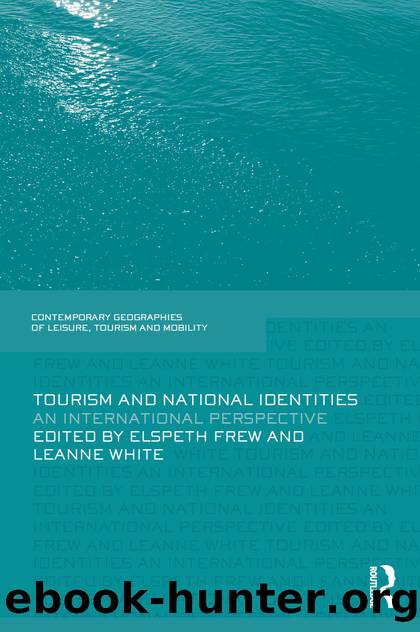Tourism and National Identities by Frew Elspeth;White Leanne;White Leanne;

Author:Frew, Elspeth;White, Leanne;White, Leanne;
Language: eng
Format: epub
Publisher: Taylor & Francis Group
Published: 2011-02-15T00:00:00+00:00
Regional, ethnic and clan identity
Central Asiaâs ethnically based republics were carved from Turkestan by the Soviets after the 1917 revolution, and there is no correspondence between their arbitrary borders, drawn up in the 1920s and 1930s, and the regionâs ethnic and linguistic situation. As a result, many border regions are the subject of international dispute. In southern Kyrgyzstan, the Osh and Batken regions comprise pockets of Uzbek and Tajik territory, the city of Osh has a large population of ethnic Uzbeks, and the border with Tajikistan is disputed. This conflict is paralleled by hostilities within Kyrgyzstan between religious, ethnic and clan groups at a number of different levels and geographic scales (Lipset 1994).
The religious affiliation of the Kyrgyz population is primarily Muslim (83 per cent) with 14 per cent Russian Orthodox (UNDP 1999), although, reflecting their nomadic heritage and the retention of many tribal traditions, they are generally less dogmatic in their beliefs than their Tajik and Uzbek neighbours. Nevertheless, the southern provinces, where 30 per cent of the population is Uzbek, are Islamic and were so even during the Soviet era. By comparison, the northern region, including Bishkek, is more Russified and liberal, with a significant concentration of Slavs, and this has tended to restrict ethnic Central Asian access to jobs, modern housing and social services (Huskey 1995). It has also increased interregional and inter-ethnic tensions, and these northâsouth contradictions are widely regarded as the main destabilising factor in society.
A further complexity is the social significance of family and clan ties. Kyrgyz identity is closely aligned with membership in one of three clan groups which also have a regional orientation. In the north and west of the country the âSolâ, or left wing, consists of seven clans, while in the south there are two clan groups: the right wing, or âOngâ, which consists of one clan (the âAdygineâ), and a second group, the âIchkilikâ, comprised of many clans, some of which are not of Kyrgyz origin (Anderson 2000). Clan loyalties dominate life on both sides of the northâsouth divide and rivalry among clans has proved to be a significant barrier to the unification of Kyrgyzstan (Schofield 2004a).
Table 9.1 International tourism arrivals and expenditure for Kyrgyzstan Year Arrival +/-(%) Expenditure(KGS)a +/-(%)
1996 48,601 â 152,737,200 â
1997 87,386 +79.8 258,198,600 +69.0
1998 59,363 -32.7 305,474,400 +18.3
1999 48,272 -18.7 512,760,600 +67.9
2000 58,756 +21.7 556,399,800 +8.5
2001 98,558 +67.7 1,163,712,000 +109.2
2002 139,589 +41.6 1,927,398,000 +65.6
2003 341,990 +144.9 2,363,790,000 +22.6
2004 737,500 +115.6 n/a â
2005 601,100 -18.5 n/a â
2006 1,500,000 +149.5 n/a â
2007 1,600,000 +6.7 12,426262,200 â
2008 1,895,000 +18.4 n/a â
Sources: National Statistical Committee of the Kyrgyz Republic (2005, 2009); UNWTO (2006); AKIpress (2008).
Note:
Download
This site does not store any files on its server. We only index and link to content provided by other sites. Please contact the content providers to delete copyright contents if any and email us, we'll remove relevant links or contents immediately.
Harry Potter and the Goblet Of Fire by J.K. Rowling(3036)
Never by Ken Follett(2877)
Shadow of Night by Deborah Harkness(2716)
Ogilvy on Advertising by David Ogilvy(2680)
Zero to IPO: Over $1 Trillion of Actionable Advice from the World's Most Successful Entrepreneurs by Frederic Kerrest(2387)
The Man Who Died Twice by Richard Osman(2293)
Machine Learning at Scale with H2O by Gregory Keys | David Whiting(2280)
Book of Life by Deborah Harkness(2263)
How Proust Can Change Your Life by Alain De Botton(2259)
My Brilliant Friend by Elena Ferrante(2221)
0041152001443424520 .pdf by Unknown(2218)
The Tipping Point by Malcolm Gladwell(2204)
How to Pay Zero Taxes, 2018 by Jeff A. Schnepper(2098)
Will by Will Smith(2039)
Purple Hibiscus by Chimamanda Ngozi Adichie(1981)
Hooked: A Dark, Contemporary Romance (Never After Series) by Emily McIntire(1944)
Borders by unknow(1785)
Rationality by Steven Pinker(1763)
Daughter of Smoke and Bone by Laini Taylor(1742)
